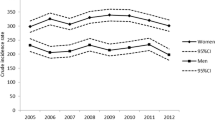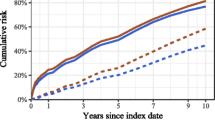Abstract
Summary
A total of 507,671 people ≥65 experienced hip fractures between 2000 and 2005. In 2005, 94,471 people ≥65 were hospitalized due to hip fractures, corresponding to a 28.5% increase over 6 years. Most fractures occurred in patients ≥75 (82.9%; n = 420,890; +16% across 6 years), particularly in women (78.2%; n = 396,967).
Introduction
We aimed to analyze incidence and costs of hip fractures in Italy over the last 6 years.
Methods
We analyzed the national hospitalization and DRG databases concerning fractures occurred in people ≥65 between 2000 and 2005.
Results
A total of 507,671 people ≥65 experienced hip fractures across 6 years, resulting in about 120,000 deaths. In year 2005 94,471 people aged ≥65 were hospitalized due to hip fractures, corresponding to a 28.5% increase over 6 years. The majority of hip fractures occurred in patients ≥75 (82.9%; n = 420,890; +16% across 6 years) and particularly in women (78.2%; n = 396,967). Among women, 84.2% of fractures (n = 334,223; +28.0% over 6 years) were experienced by patients ≥75, which is known to be the age group with the highest prevalence of osteoporosis, accounting for 68.6% of the overall observed increase in the total number of fractures. Hip fractures in men ≥75 increased by 33.1% (up to 16,540). Hospitalization costs increased across the six examined years (+36.1%) reaching 467 million euros in 2005, while rehabilitation costs rose up to 531 million in the same year.
Conclusions
Hip fractures of the elderly are increasing and represent a major health problem in industrialized countries such as Italy.

Similar content being viewed by others
References
National Institute for Statistics (2005) Italian Statistics. National Institute for Statistics, Rome
WHO statistical information system (WHOSIS), http://apps.who.int/whosis/database/life_tables/life_tables_process.cfm?path=whosis,life_tables&language=english
Italian Senate Health Commission (eds) (2002) Official Report of the Survey on Osteoporosis. Italian Senate, Rome
Kanis JA et al (2008) European guidance for the diagnosis and management of osteoporosis in postmenopausal women. Osteoporos Int 19(4):399–428
Piscitelli P, Guida G, Iolascon G et al (2007) Incidence and costs of hip fractures vs. acute myocardial infarction in the Italian population: a 4 years survey. Osteoporos Int 18:211–219
Keene GS, Parker MJ, Pryor GA (1993) Mortality and morbidity after hip fractures. BMJ 307:1248–1250
Meyer HE, Tverdal A, Falch JA, Pedersen JI (2000) Factors associated with mortality after hip fracture. Osteoporos Int 11:228–232
Hagsten B et al (2006) Health-related quality of life and selfreported ability concerning ADL and IADL after hip fracture: a randomized trial. Acta Orthop 77(1):114–119
Di Monaco M et al (2006) Muscle mass and functional recovery in women with hip fracture. Am J Phys Med Rehabil 85(3):209–215
Zimmermann S et al (2006) The lower extremity gain scale: a performance-based measure to assess recovery after hip fracture. Arch Phys Med Rehabil 87(3):430–436
Latham NK (2006) Pattern of functional change during rehabilitation of patients with hip fracture. Arch Phys Med Rehabil 87(1):111–116
Adami S, Giannini S, Giorgino R et al (2003) The effect of age, weight, and lifestyle factors on calcaneal quantitative ultrasound: the ESOPO study. Osteoporos Int 14:198–207
Siris ES, Brenneman SK, Barrett-Connor E, Miller PD, Sajjan S, Berger ML, Chen YT (2006) The effect of age and bone mineral density on the absolute, excess, and relative risk of fracture in postmenopausal women aged 50–99: results from the National Osteoporosis Risk Assessment (NORA). Osteoporos Int 17(4):565–574
Krieg MA, Cornuz J, Ruffieux C et al (2006) Prediction of hip fracture risk by quantitative ultrasound in more than 7000 Swiss women > or =70 years of age: comparison of three technologically different bone ultrasound devices in the SEMOF study. J Bone Miner Res 21(9):1457–1463
Maggi S et al (2006) Quantitative heel ultrasound in a population-based study in Italy and its relationship with fracture history: the ESOPO study. Osteoporos Int 17:237–244
Riggs BL, Melton LJ 3rd (1995) The worldwide problem of osteoporosis: insights afforded by epidemiology. Bone 17(5 Suppl):505S–511S17
Iolascon G, Guida G et al (2007) Hip fractures in Italy, analysis of DRG data. Aging Clin Exp Res 19(3):2–4
Piscitelli P, Iolascon G, Guida G et al (2005) Femoral fractures and orthopaedic surgery in Italy. J Orthopaed Traumatol 6:202–205
Piscitelli et al (2006) Incidence and costs of hip fractures vs. acute myocardial infarction in the population of Local Health Authorities ASL Lecce/1 and ASL Lecce/2: a 2 years survey. Ital J Public Health 3(2):75–77 Year 4
Browner WS, Pressman AR, Nevitt MC, Cummings SR (1996) Mortality following fractures in older women. The study of osteoporotic fractures. Arch Intern Med 156:1521–1525
Center JR, Nguyen TV, Schneider D et al (1999) Mortality after all major types of osteoporotic fracture in men and women: an observational study. Lancet 353(9156):878–882
Tediosi F et al (2003) La valutazione economica dei percorsi assistenziali dei soggetti con Ictus e frattura femore in toscana. Mecosan 48(1):67–82 article in Italian
Visentin P, Ciravegna R, Fabris F (1997) Estimating the cost per avoided hip fracture by osteoporosis treatment in Italy. Maturitas 26:185–192
Tediosi F et al (2004) L'assistenza ospedaliera e riabilitativa per le fratture osteoporotiche in Toscana. Polit Sanit 5(2):61–69 (article in Italian)
Icks A, Haastert B, Becker C, Meyer G (2008) Trend of hip fracture incidence in Germany 1995–2004: a population-based study. Osteoporos Int 19:1139–1145
Maravic M, Le Bihan C, Landais P, Fardellone P (2005) Incidence and cost of osteoporotic fractures in France during 2001. A methodological approach by the national hospital database. Osteoporos Int 16:1475–1480
Mann E, Icks A, Haastert B, Meyer G (2009) Hip fracture incidence in the elderly in Austria: an epidemiological study covering the years 1994 to 2006. BMC Geriatr 8:35 2008
Caldarola P, Cuonzo M et al (2008) Epidemiology of heart failure in Apulia Region. G Ital Cardiol 10:135–139
Lippuner K, von Overbeck J, Perrelet R et al (1997) Incidence and direct medical costs of hospitalizations due to osteoporotic fractures in Switzerland. Osteoporos Int 7:414
Lippuner K et al (2005) Epidemiology and direct medical costs of osteoporotic fractures in men and women in Switzerland. Osteoporos Int 16(SUP 2):S8–S17
Pervez H, Bhargwa A, Parker MJ (2003) Accuracy and reliability of the clinical indicators related to hip fractures. Injury 34:522–524
International Osteoporosis Foundation (2002) Osteoporosis in the European Community: a call for action. International Osteoporosis Foundation, Lyon
Autier P, Haentjens P, Bentin J et al (2000) Costs induced by hip fractures: a prospective controlled study in Belgium. Belgian Hip Fracture Study Group. Osteoporos Int 11:373–380
Dolan P, Torgerson DJ (1998) The cost of treating osteoporosis fractures in the United Kingdom female population. Osteoporos Int 8:611–617
Johnell O, Gullberg B, Allander E, Kanis JA (1992) The apparent incidence of hip fracture in Europe: a study of national register sources.MEDOS Study Group. Osteoporos Int 2:298–302
Vestergaard P, Rejnmark L, Mosekilde L (2008) Strongly increasing incidence of hip fractures in Denmark from 1977 to 1999. Ugeskr Laeger 170:621–623
Hernandez JL, Olmos JM, Alonso MA, Gonzales-Fernandez CR, Martinez J, Pajaron M, Llorca J, Gonzales-Macias J (2006) Trend in hip fracture epidemiology over a 14-year period in a Spanish population. Osteoporos Int 17:464–470
Lönnroos E, Kautianinen H, Karppi P, Huusko T, Kiviranta I, Sulkava R (2006) Increased incidence of hip fractures. A population based-study in Finland. Bone 39:623–627
Bjorgul K, Reikeras O (2007) Incidence of hip fracture in southeastern Norway. Int Orthop 31:665–669
Ray NF, Chan JK, Thamer M, Melton LJ 3rd (1997) Medical expenditures for treatment of osteoporotic fractures in the United States in 1995: report from the National Osteoporosis Foundation. J Bone Miner Res 12(1):24–35
Hagino H, Katagiri H, Okano T, Yamamoto K, Teshima R (2005) Increasing incidence of hip fracture in Tottori Prefecture, Japan: trend from 1986 to 2001. Osteoporos Int 16:1963–1968
Löfmann O, Berglund K, Larsson L, Toss G (2002) Changes in hip fracture epidemiology: redistribution between ages, genders and fracture types. Osteoporos Int 13:18–25
Chevalley T, Guilley E, Herrmann FR, Hoffmeyer P, Rapin CH, Rizzoli R (2007) Incidence of hip fracture over a 10-year period (1991–2000): reversal of a secular trend. Bone 40:1284–1289
Chang KP, Center JR, Nguyen TV, Eisman JA (2004) Incidence of hip and other osteoporotic fractures in elderly men and women: Dubbo Osteoporosis Epidemiology Study. J Bone Miner Res 19:532–536
Jaglal SB, Weller I, Mamdani M, Hawker G, Kreder H, Jakkimainen L, Adachi JD (2005) Population trends in BMD testing, treatment, and hip and wrist fracture rates: are the hip fracture projections wrong? J Bone Miner Res 20:898–905
Sugarman JR, Connell FA, Hansen A, Helgerson SD, Jessup MC, Lee H (2002) Hip fracture incidence in nursing home residents and community-dwelling older people, Washington State, 1993–1995. J Am Geriatr Soc 50:1638–1643
Borgstrom F et al (2007) The societal burden of osteoporosis in Sweden. Bone 40(6):1602–1609
Acknowledgments
We thank Dr. L. Lispi and D. Del Gigante (General Direction for Planning Affairs, Italian Ministry of Health) for their help in the analysis of national hospitalization data. Many thanks to the CERSUM research group on osteoporosis (Euro Mediterranean Scientific Biomedical Institute, ISBEM/IFC CNR, Brindisi).
Conflicts of interest
AD, AM, SG, PM, MM, EQ, FC, FF, GC, MLB, GC, AG, GG, RG, GI have received research grant and funding for consulting/speaking by Merck, Sanofi-Aventis, Novartis, Stroder-Servier, Procter & Gamble, Ely Lilly, Roche, Glaxo; PP has received once funding for consulting/speaking by Sanofi-Aventis; FG, AM, GC, MC, LDP, MB, ES, OB, BF: no disclosures.
Author information
Authors and Affiliations
Corresponding author
Rights and permissions
About this article
Cite this article
Piscitelli, P., Gimigliano, F., Gatto, S. et al. Hip fractures in Italy: 2000–2005 extension study. Osteoporos Int 21, 1323–1330 (2010). https://doi.org/10.1007/s00198-009-1084-x
Received:
Accepted:
Published:
Issue Date:
DOI: https://doi.org/10.1007/s00198-009-1084-x




